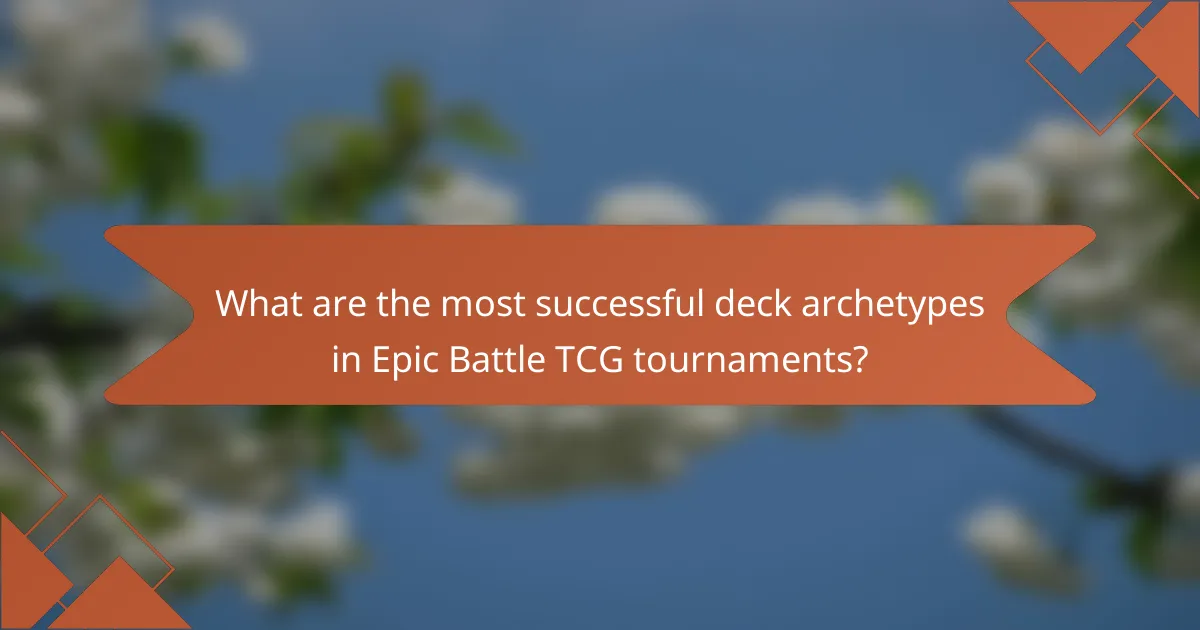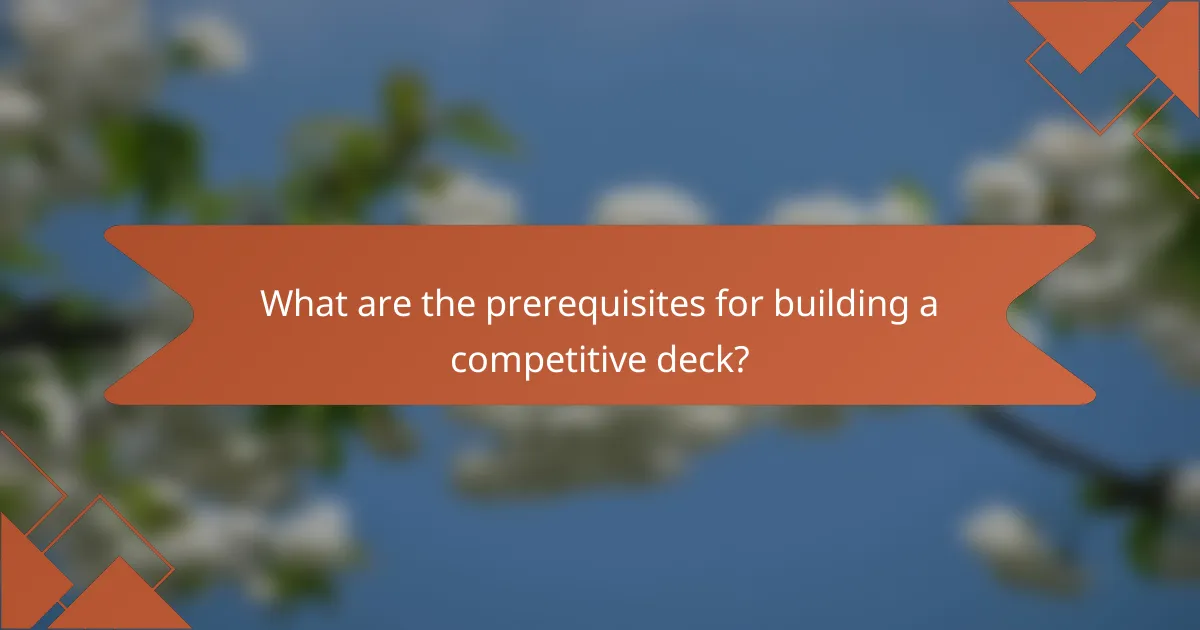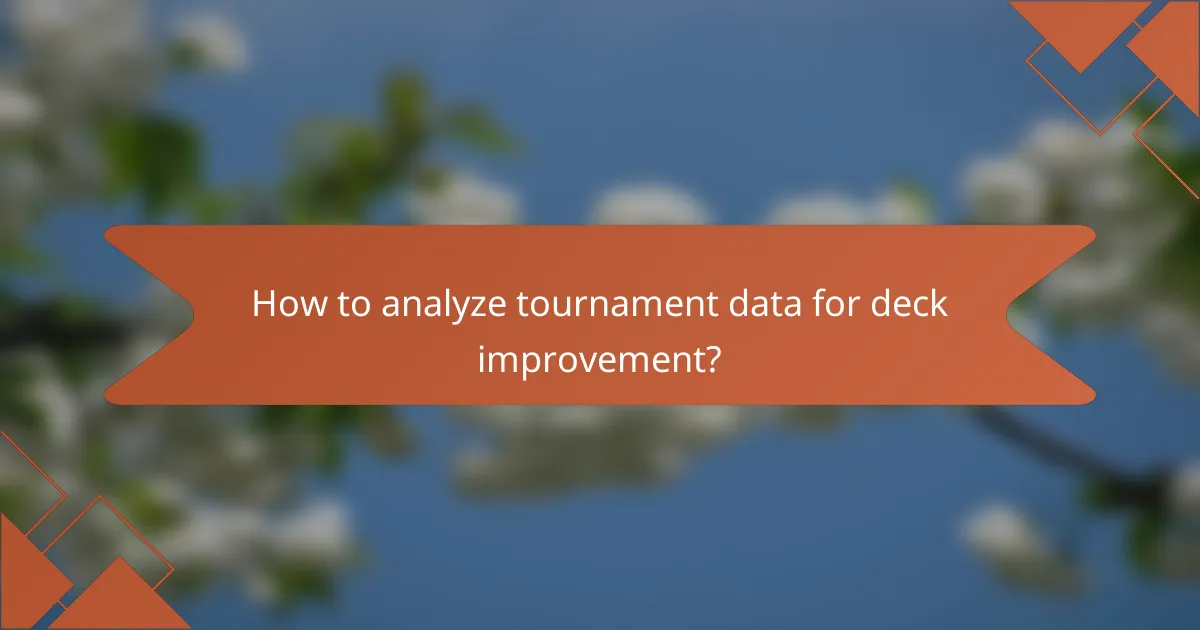In Epic Battle TCG tournaments, understanding the most successful deck archetypes—Control, Aggro, Combo, Midrange, and Ramp—is crucial for players aiming to enhance their competitive edge. Each archetype offers unique strategies and strengths that can be leveraged to navigate the complexities of the current meta. By analyzing these archetypes, players can tailor their decks to effectively counter popular strategies and improve their overall performance in tournaments.

What are the most successful deck archetypes in Epic Battle TCG tournaments?
The most successful deck archetypes in Epic Battle TCG tournaments include Control, Aggro, Combo, Midrange, and Ramp decks. Each archetype has distinct strategies and strengths that can lead to victory, depending on the player’s style and the current meta.
Control Decks
Control decks focus on managing the game by neutralizing threats and outlasting opponents. They typically employ a variety of removal spells and defensive strategies to maintain board control. Players should prioritize card advantage and resource management to wear down aggressive opponents.
Common cards in Control decks often include powerful spells that can counter enemy plays or draw additional cards. A successful Control deck might feature a mix of low-cost removal and high-impact late-game threats to secure victory once the opponent is exhausted.
Aggro Decks
Aggro decks aim to defeat opponents quickly by applying early pressure and overwhelming them with fast, aggressive plays. These decks often utilize low-cost creatures and direct damage spells to reduce the opponent’s life total rapidly. Players should focus on maintaining tempo and maximizing damage output in the early turns.
Typical Aggro strategies involve deploying creatures on the first few turns and using burn spells to finish off opponents. A well-constructed Aggro deck might include cards that can deal damage directly to the opponent or force them to block, ensuring a swift victory.
Combo Decks
Combo decks rely on specific card combinations to achieve powerful effects that can win the game in a single turn. These decks often require careful planning and resource management to assemble the necessary pieces. Players should be aware of potential disruptions and have backup plans in case their combo is interrupted.
Successful Combo decks may include cards that search for key components or protect the combo from disruption. Understanding the timing and sequence of plays is crucial, as executing a combo often requires precise conditions to be met.
Midrange Decks
Midrange decks strike a balance between Aggro and Control, featuring a mix of efficient creatures and spells that can adapt to various situations. These decks can apply pressure while also having the tools to respond to threats. Players should aim to control the board while developing their own threats.
A typical Midrange deck might include versatile cards that can serve multiple purposes, allowing for flexibility in gameplay. This adaptability makes Midrange decks effective against a wide range of opponents, but players must be mindful of their resource allocation to maintain momentum.
Ramp Decks
Ramp decks focus on accelerating resource generation to play powerful cards earlier than usual. By utilizing spells and abilities that increase mana production, these decks can deploy high-cost creatures and spells ahead of the curve. Players should prioritize card draw and mana efficiency to maximize their ramp potential.
Common strategies in Ramp decks involve using cards that generate additional mana or reduce the cost of spells. A successful Ramp deck often features a mix of early-game ramp cards and late-game threats that can dominate the board once established.

How do deck archetypes impact tournament outcomes?
Deck archetypes significantly influence tournament outcomes by determining strategies, synergies, and overall performance. Understanding these archetypes allows players to tailor their decks to counter prevalent strategies and optimize their chances of success.
Win Rates
Win rates are a crucial metric for evaluating the effectiveness of different deck archetypes in tournaments. Generally, successful archetypes can achieve win rates ranging from the mid-forties to the mid-sixties percent, depending on the current meta and player skill. Players should analyze historical tournament data to identify which archetypes consistently perform well.
For example, aggressive decks often excel in early rounds, while control decks may shine in later stages. It’s essential to consider the win rates of archetypes against specific matchups to make informed decisions about deck selection.
Meta Influence
The meta, or the prevailing trends in deck strategies, greatly affects how archetypes perform in tournaments. A strong meta can elevate certain archetypes, making them more viable, while others may struggle to compete. Players should stay updated on the meta to adjust their decks accordingly, ensuring they are prepared for common threats.
For instance, if a particular archetype becomes dominant, counter-strategies may emerge, leading to shifts in win rates. Regularly reviewing tournament results and community discussions can provide insights into these changes, helping players refine their deck choices to align with the evolving meta landscape.

What strategies enhance deck performance in tournaments?
Successful deck performance in tournaments relies on a combination of card synergy, resource management, and matchup knowledge. These strategies help players optimize their decks for competitive play, ensuring they can adapt to various opponents and scenarios.
Card Synergy
Card synergy refers to the interaction between cards that enhances their effectiveness when played together. A well-constructed deck should feature cards that complement each other, creating powerful combinations that can turn the tide of a match. For example, pairing cards that boost attack power with those that provide additional draws can create a cycle of aggressive plays.
When building your deck, prioritize cards that share themes or mechanics. This could mean focusing on a specific faction or utilizing cards that trigger effects when certain conditions are met. Avoid including cards that do not contribute to your overall strategy, as they can dilute your deck’s effectiveness.
Resource Management
Resource management is crucial in Epic Battle TCG, as it involves effectively utilizing cards, energy, and other assets to maintain a competitive edge. Players should aim to balance their resource expenditure, ensuring they have enough to execute their strategies while not overcommitting to any single play. A common pitfall is running out of resources too early, leaving you vulnerable.
Consider implementing cards that generate additional resources or provide cost reductions. For instance, cards that allow you to draw extra cards or reduce the energy cost of your plays can significantly enhance your ability to maintain pressure on your opponent. Regularly assess your resource pool and adjust your plays accordingly to avoid running dry.
Matchup Knowledge
Understanding matchup knowledge involves being aware of the strengths and weaknesses of your deck against various opponents. This knowledge allows players to anticipate strategies and adjust their gameplay accordingly. Familiarize yourself with popular decks in the current meta to identify potential threats and tailor your deck to counter them.
To improve your matchup knowledge, practice against a variety of decks and analyze the outcomes. Keep track of which strategies work best against specific archetypes and refine your approach based on these experiences. This proactive preparation can give you a significant advantage in tournament settings.

What are the prerequisites for building a competitive deck?
To build a competitive deck in Epic Battle TCG tournaments, players need to consider card availability and their own skill level. These factors significantly influence deck performance and overall success in competitive play.
Card Availability
Card availability refers to the accessibility of specific cards needed to construct a competitive deck. Players should focus on acquiring cards that are currently popular in the meta, as well as those that synergize well with their chosen strategy. Checking local game stores, online marketplaces, and trading with other players can enhance card collection.
It’s beneficial to prioritize cards that are versatile and can fit into multiple deck archetypes. This approach not only maximizes the utility of each card but also allows for easier adjustments to the deck as the meta evolves. Keeping an eye on upcoming expansions can also provide insights into potential new additions to your deck.
Player Skill Level
Player skill level is crucial when building a competitive deck, as it determines how effectively one can utilize the cards at their disposal. A well-constructed deck can underperform in the hands of a less experienced player, while a skilled player can maximize the potential of a simpler deck. Understanding your own strengths and weaknesses can guide your deck-building choices.
To improve skill level, players should engage in regular practice, participate in local tournaments, and analyze their gameplay. Watching replays of successful players and studying their strategies can also provide valuable insights. Balancing deck complexity with personal expertise is key; a deck that is too intricate may lead to mistakes, while a simpler deck may not fully exploit a player’s strengths.

How to analyze tournament data for deck improvement?
To analyze tournament data for deck improvement, focus on gathering and interpreting match statistics and player feedback. These insights will help identify strengths and weaknesses in your deck, guiding adjustments for better performance in future tournaments.
Match Statistics
Match statistics provide quantitative data on how your deck performs against various opponents. Key metrics include win rates, average game duration, and matchups against popular archetypes. For instance, if your deck has a win rate below 50% against a specific archetype, it may indicate a need for strategic adjustments.
Consider tracking performance over multiple tournaments to identify trends. A deck that consistently underperforms in certain matchups may require card swaps or a shift in strategy. Use tools or platforms that aggregate tournament data to streamline this analysis.
Player Feedback
Player feedback is invaluable for understanding the qualitative aspects of your deck’s performance. Engaging with fellow players after matches can reveal insights into your deck’s strengths and weaknesses that statistics alone may not capture. Ask for specific feedback on card choices and strategies used during gameplay.
Incorporate this feedback into your analysis by noting common themes or suggestions. For example, if multiple players suggest that a particular card is underperforming, consider replacing it with a more effective alternative. Balancing statistical analysis with player insights can lead to more comprehensive deck improvements.

What are the emerging trends in Epic Battle TCG deck building?
Emerging trends in Epic Battle TCG deck building focus on innovative strategies and adapting to shifting metas. Players are increasingly exploring unique archetypes and refining their decks to counter popular strategies, making flexibility and creativity essential for success.
Innovative Archetypes
Innovative archetypes in Epic Battle TCG often blend traditional strategies with new mechanics or card synergies. For example, decks that combine aggressive early-game pressure with late-game control elements are gaining traction. This hybrid approach allows players to adapt their tactics based on the opponent’s strategy.
Another trend is the rise of combo decks that rely on specific card interactions to achieve victory. These decks require precise timing and resource management, making them rewarding for skilled players. However, they can be vulnerable to disruption, so it’s crucial to include defensive options to protect key pieces.
Meta Shifts
Meta shifts in Epic Battle TCG occur as players respond to the most successful strategies in tournaments. For instance, if control decks dominate, aggressive strategies may rise to counter them. Staying informed about these shifts is vital for deck optimization and tournament preparation.
To adapt to meta changes, players should regularly analyze tournament results and popular deck lists. Keeping track of which archetypes are performing well can help in adjusting card choices and strategies. A common pitfall is sticking to outdated decks; flexibility in deck building is key to maintaining competitiveness.
